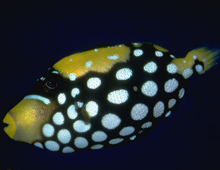Description: The Clown triggerfish is considered by many to be the most beautiful of the Balistidae family, with its unique color pattern. The black body is highlighted with a bright yellow that is freckled with small round black spots. On the bottom half of the body are somewhat circular larger spots that are white. The lips are bright yellow with a white line circling the mouth behind the lips. There is also a white stripe below the masked eyes and one on the caudal fin. Males and females look alike; juveniles have more spots that fade with age and they also lack the yellow lips.
Size: They reach a length of approximately 20 inches (50 cm).
Behavior: Activity is mainly diurnal for these quite territorial fish that will hide in crevices if threatened. They are normally solitary but can also be seen in pairs. Their aggressive attitude is most evident when guarding their nests. Triggerfish usually breed in harems, which consists of a male and two to five females. Males will protect their females and young. Triggerfish “wedge” themselves into crevices or holes in coral by use of a set of spines. The spines lock the fish in place, and can only be unlocked by depressing the smaller “trigger” spine to disengage the larger spine.
Diet: Clown triggerfish use their sharp teeth to feed on urchins, crabs, other crustaceans, mollusks and sea squirts.
Reproduction: Spawning takes place in areas that are sandy or contain coral rubble. A shallow hole is dug in which the female lays the eggs. After fertilization, the nests are guarded and fanned by the male for about eight days at which time they hatch.
Habitat/range: They live in the portions of a reef where shellfish and other food is most plentiful in temperate and tropical waters of the Pacific and Indian Ocean (Africa to islands in the central Pacific).
Status: Not listed by IUCN or CITES.



